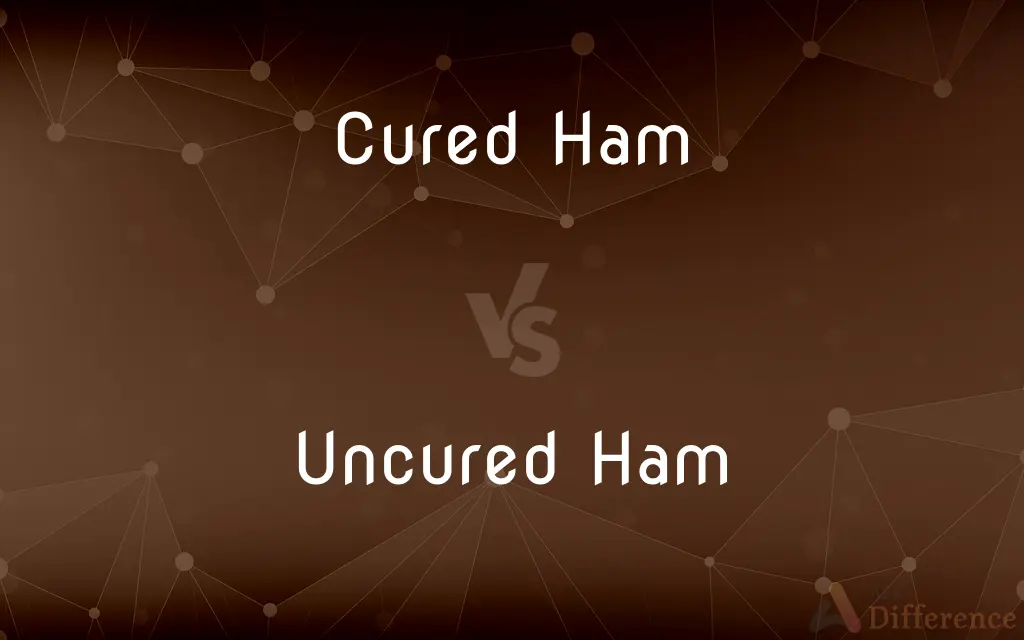Cured Ham vs. Uncured Ham — What's the Difference?
By Tayyaba Rehman & Urooj Arif — Published on April 25, 2024
Cured ham is preserved with salts, nitrates, or sugar, giving it a distinct flavor and pink color, whereas uncured ham, labeled as such for marketing, still uses natural curing agents but lacks synthetic nitrates, offering a more natural taste.

Difference Between Cured Ham and Uncured Ham
Table of Contents
ADVERTISEMENT
Key Differences
Cured ham undergoes a preservation process involving salts, nitrates, or sugar, which not only extends its shelf life but also imparts a unique flavor and a pinkish color. This traditional method of curing includes both dry-curing and wet-curing techniques. On the other hand, uncured ham, despite its name, is also cured but uses only natural sources of nitrates, such as celery juice or sea salt. This approach aims to provide a healthier option without synthetic chemicals, though it still undergoes a similar preservation process.
The main difference between cured and uncured ham lies in the curing agents used. Cured ham often contains synthetic nitrates and nitrites, which are added for color retention and to prevent bacterial growth. Uncured ham, conversely, relies on natural ingredients, which contain nitrates but do not have the same concentration of chemical preservatives. This distinction affects not only the nutritional profile but also the taste and texture of the ham.
From a health perspective, consumers often choose uncured ham to avoid the synthetic nitrates and nitrites associated with health risks, including certain types of cancer. However, it's important to note that even natural sources of nitrates can convert to nitrites in the body, potentially posing similar health risks. Therefore, the choice between cured and uncured ham might not be as clear-cut in terms of health benefits as it seems.
In terms of flavor, cured ham tends to have a more pronounced and distinct taste, attributed to the specific combination of curing agents and the curing process itself. Uncured ham, while still flavorful, offers a taste that is closer to that of fresh pork, with subtle differences influenced by its natural curing agents.
Shelf life is another differentiating factor. Cured ham, thanks to its synthetic preservatives, often boasts a longer shelf life compared to uncured ham. This makes cured ham a more convenient option for storage and consumption over extended periods, while uncured ham might require more immediate consumption or careful storage.
ADVERTISEMENT
Comparison Chart
Curing Agents
Synthetic nitrates/nitrites, salts, sugar
Natural sources like celery juice or sea salt
Flavor
Distinct, often salty or sweet, with a deep pink color
Milder, closer to fresh pork, with a less pronounced color
Health Considerations
Contains synthetic nitrates/nitrites associated with health risks
Marketed as healthier due to natural curing agents, though still contains nitrates
Shelf Life
Longer due to synthetic preservatives
Shorter, requires more immediate consumption
Curing Process
Can be dry-cured or wet-cured
Similar processes but uses only natural ingredients
Compare with Definitions
Cured Ham
Cured ham is a pork product preserved through salting, nitrating, or sugaring.
The chef's special included thinly sliced cured ham with melon.
Uncured Ham
Marketed as a healthier option due to the absence of synthetic nitrates.
We chose uncured ham to avoid artificial additives.
Cured Ham
Cured ham is known for its long shelf life.
We stored the cured ham in the pantry for months without spoilage.
Uncured Ham
It offers a flavor closer to fresh pork than cured ham.
Uncured ham's subtle flavors were perfect for the light lunch menu.
Cured Ham
This ham variety is ideal for dishes requiring pronounced flavors.
For the festive dinner, we prepared a glazed cured ham.
Uncured Ham
It maintains a more natural taste and color.
For the charcuterie board, we selected an uncured ham for its natural qualities.
Cured Ham
It often features a deep pink color and a robust flavor.
The cured ham had a savory taste that complemented the cheese platter.
Uncured Ham
Uncured ham is labeled as such for marketing, but it's cured with natural ingredients.
The uncured ham we bought uses celery juice for curing.
Cured Ham
It may contain synthetic preservatives for curing.
I prefer cured ham for its distinct taste, despite its preservatives.
Uncured Ham
Requires more immediate consumption compared to cured ham.
The uncured ham in the fridge should be eaten within the week.
Common Curiosities
Is uncured ham healthier than cured ham?
Uncured ham is perceived as healthier due to its natural curing agents, though both contain nitrates, which have associated health risks.
Can both cured and uncured ham be eaten raw?
Yes, both types of ham can be consumed without cooking if they are pre-cooked or dry-cured.
Why does cured ham have a longer shelf life?
The synthetic preservatives in cured ham extend its shelf life compared to the natural ingredients in uncured ham.
How are cured and uncured hams preserved?
Cured ham uses synthetic nitrates and traditional methods, while uncured ham relies on natural curing agents.
What makes uncured ham different?
Despite its name, uncured ham is also cured but uses natural sources like celery juice for preservation, avoiding synthetic nitrates.
Do cured and uncured hams come from a specific type of pig?
No, both can come from any pork, but the breed and diet of the pig can influence the flavor.
Can I substitute uncured ham for cured ham in recipes?
Yes, but expect a difference in flavor and color in the final dish.
What is cured ham?
Cured ham is pork preserved using salts, nitrates, or sugar, giving it a distinct flavor and color.
Are the nitrates in uncured ham safer than those in cured ham?
Natural nitrates in uncured ham convert to nitrites similar to synthetic ones in cured ham, posing similar health risks.
How should uncured ham be stored?
Uncured ham should be refrigerated and consumed more quickly than cured ham due to its shorter shelf life.
Can curing methods affect the nutritional content of ham?
Yes, the type of curing can influence sodium content and other nutritional aspects of the ham.
Is it easy to find uncured ham in grocery stores?
Yes, uncured ham has become more widely available due to increasing consumer demand for natural products.
Is there a taste difference between cured and uncured ham?
Yes, cured ham tends to have a more pronounced flavor, while uncured ham tastes closer to fresh pork.
Why do some prefer cured ham over uncured?
Some prefer the distinct taste and longer shelf life of cured ham, along with its traditional preparation methods.
Why is uncured ham sometimes more expensive?
The natural ingredients and perceived health benefits of uncured ham can make it more costly.
Share Your Discovery
Previous Comparison
Acetoxy Silicone vs. Neutral Cure Silicone
Next Comparison
Myotherapy vs. Remedial MassageAuthor Spotlight
Written by
Tayyaba RehmanTayyaba Rehman is a distinguished writer, currently serving as a primary contributor to askdifference.com. As a researcher in semantics and etymology, Tayyaba's passion for the complexity of languages and their distinctions has found a perfect home on the platform. Tayyaba delves into the intricacies of language, distinguishing between commonly confused words and phrases, thereby providing clarity for readers worldwide.
Co-written by
Urooj ArifUrooj is a skilled content writer at Ask Difference, known for her exceptional ability to simplify complex topics into engaging and informative content. With a passion for research and a flair for clear, concise writing, she consistently delivers articles that resonate with our diverse audience.













































